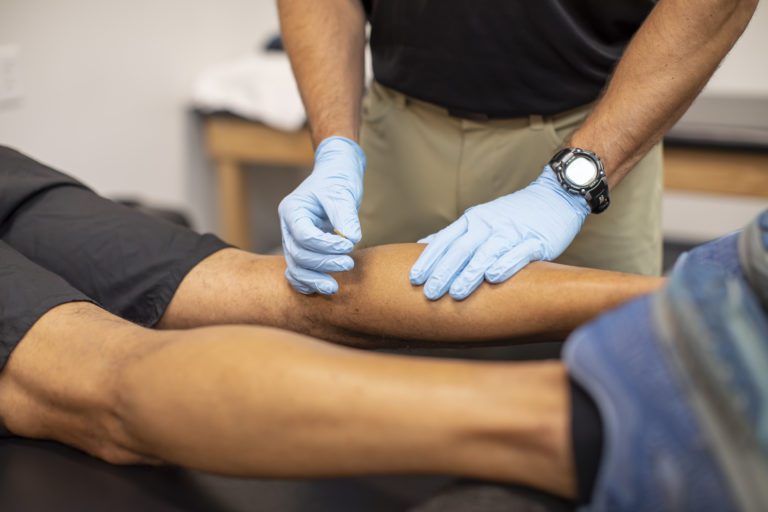
Dry Needling – What is it?
Dry needling is a relatively new treatment option in the US, having only been around for 30 years or so, but its popularity is rapidly rising due to the numerous benefits it provides for pain relief and range of motion.
What is dry needling?
In simple terms, dry needling is a safe and effective way to ease muscle pain. The technique involves thin needles, similar to those used in acupuncture, to pinpoint trigger points and tight knots that cause pain. Because of the ability to loosen stiff muscles, ease joint pain, and improve blood flow and oxygen circulation, dry needling can provide positive results for those who are trying to relieve pain, enhance sports performance, recover faster from an injury, or prevent and reduce chronic pain.
Dry needling can relieve acute and chronic pain:
- Neck and back pain
- Frozen shoulder
- Tennis elbow
- Muscle spasms, strains, and sprains
- Repetitive strain injuries
- Calf, shin, and knee pain
- Headaches
- Sciatica
- Plantar fasciitis
- Pelvic pain
- Myofascial pain
- Fibromyalgia
- Chronic pain
- Movement disorders
Benefits of Dry Needling
Relieve Pain and Muscle Tightness
Think of dry needling as a way to “reset” your muscles. A physical therapist can identify the knots and trigger points that are causing you pain and use dry needling to help restore the muscle back to its normal length. In addition, the needles will reduce inflammation, tension, and pressure on the muscle. Once the muscle has relaxed you will experience pain relief and improved blood flow.
Improved Range of Motion
Why is range of motion so important? Let’s say you’re an athlete or even a hobbyist who enjoys gardening or golfing – either way, you’re always moving. You put a lot of stress on your joints, muscles, and in some cases, certain parts of the body encounter repetitive stress in the same area. Relaxed muscles that aren’t tight are able to move freely and extend farther – increasing the range of motion.
Speed Up Recovery
Anytime you suffer an injury, the recovery process can be the hardest part. Some injuries require longer periods of recovery than others, but no matter the amount of time, the end goal is to get back to full strength as quickly as possible. Experience has shown that patients who have undergone dry needling, compared to other treatment options, have experienced a faster healing process in regard to pain relief and range of motion.
How is dry needling different from acupuncture?
Some people associate dry needling with acupuncture, and while the two practices use the same type of needles, the similarities stop there. Physical therapists who practice dry needling are releasing tension from knots and pressure points in the muscle. Acupuncturists insert needles to release endorphins and affect the nervous system. Traditionally, acupuncture is used to align a person’s energy or chi.
Schedule a dry needling appointment
Are you ready to give dry needling a try, or do you want to learn more? Request an appointment online at a location near you!
Article Reviewed by Holly Lookabaugh-Deur, PT, DSc, GCS, CEEAA
Holly Lookabaugh-Deur, PT, DSc, GCS, CEEAA is a practicing physical therapist and a partner and Director of Clinical Services at Ivy Rehab Network. Deur is board certified as a geriatric clinical specialist and certified exercise expert for aging adults with more than 35 years of clinical experience. She is certified as an aquatic and oncology rehabilitation specialist and serves as adjunct faculty at Central Michigan University and Grand Valley State University.
The medical information contained herein is provided as an information resource only, and does not substitute professional medical advice or consultation with healthcare professionals. This information is not intended to be patient education, does not create any patient-provider relationship, and should not be used as a substitute for professional diagnosis, treatment or medical advice. Please consult with your healthcare provider before making any healthcare decisions or for guidance about a specific medical condition. If you think you have a medical emergency, call your doctor or 911 immediately. IvyRehab Network, Inc. disclaims any and all responsibility, and shall have no liability, for any damages, loss, injury or liability whatsoever suffered as a result of your reliance on the information contained herein.